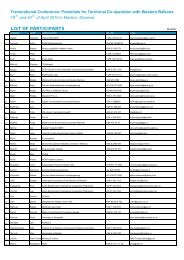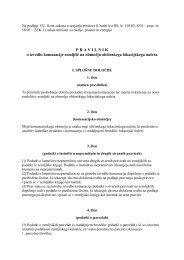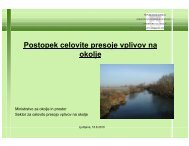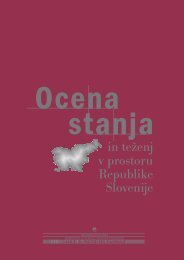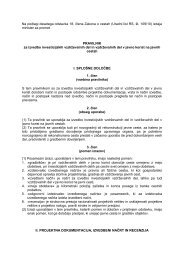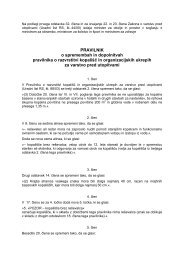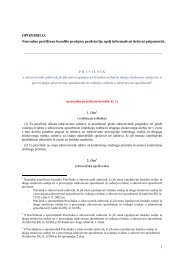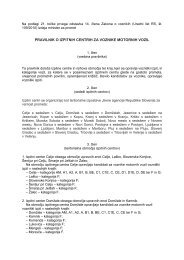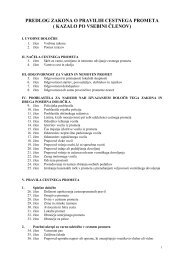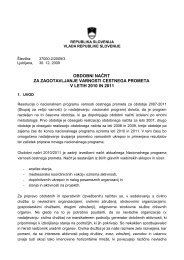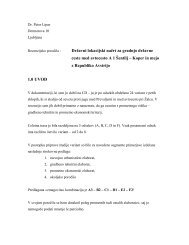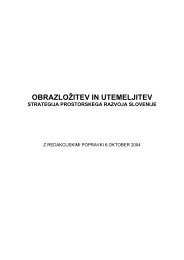evropska konvencija o krajini - Ministrstvo za infrastrukturo in prostor
evropska konvencija o krajini - Ministrstvo za infrastrukturo in prostor
evropska konvencija o krajini - Ministrstvo za infrastrukturo in prostor
Create successful ePaper yourself
Turn your PDF publications into a flip-book with our unique Google optimized e-Paper software.
244Delavnica 3 / Workshop 3preobremenjenih <strong>in</strong> prenatrpanih prometnihomrežij. Ne bi se smeli omejiti na ublažitevvpliva, ki ga imajo ti <strong>in</strong>frastrukturni objekti namaloštevilne odprte <strong>prostor</strong>e, preko katerihpotekajo, tako, da bi jih skušali odstraniti izvsakega kraja urbani<strong>za</strong>cije, pač pa moramopredvsem graditi kontekste velikih parkov, ki bise lahko uporabljali kot novi javni <strong>prostor</strong>i vskladu z razvojem nove urbane strukture neglede na njeno velikost.Ne smemo po<strong>za</strong>biti nastajanja novega sistemazgodov<strong>in</strong>skih centrov <strong>in</strong> »suburbanih nakupovalnihcentrov« z mega k<strong>in</strong>odvoranami ter pravtako ne novih šolskih ustanov, novih kulturnihcentrov, novih javnih podjetij <strong>in</strong> celo novihletališč.Infrastrukturna politikane bi smela spregledatipostopnega pojavljanja drugačnega razvojnegamodela v manj naseljenih območjih, ki ga lahkos<strong>in</strong>tetizirano opredelimo kot »počasnega«(slow); tu je poudarek na območjih, <strong>za</strong> katera soznačilne različne oblike lahke <strong>in</strong>dustrije vdruž<strong>in</strong>skem upravljanju, ki so v nekaterihprimerih nadomestile kmetijske dejavnosti, <strong>in</strong> kise osredotočajo na turizem <strong>in</strong> obrtne izdelke vnovem kontekstu višjega vrednotenja postopnihsprememb kraj<strong>in</strong>e <strong>in</strong> urbani<strong>za</strong>cije.Razvoj teh območij <strong>za</strong>hteva dobro dostopnost <strong>in</strong>omrežje <strong>in</strong>frastrukturnih objektov, ki omogočazmeren pretok z možnostjo postankov, <strong>za</strong>to jetreba te objekte zgraditi na tak nač<strong>in</strong>, da neuničijo podedovane kraj<strong>in</strong>e, ki postaja velikoveč kot element, ki ga je vredno <strong>za</strong>varovati,upoštevajoč lastnosti teh objektov, ki sopomemben vidik razločevanja.Zato je, čeprav območja brez <strong>in</strong>frastrukturnegaprojekta predstavljajo prv<strong>in</strong>o izboljšanja <strong>in</strong>obnove (reforme) kraj<strong>in</strong>e, ki bi lahko vključevalaponovno kontekstualno pretehtanje obsežnihokoliških območij, tukaj potrebno trajnostnolokalno upravljanje sprememb <strong>in</strong> ohranjanjakraj<strong>in</strong>e, tako da se <strong>za</strong>gotovi dobro prilagajanje žeobstoječim <strong>in</strong> <strong>in</strong>ovativnim strukturam. Zlasti jetreba v njihovem kontekstu znova pretehtatiprometne <strong>in</strong>frastrukturne objekte na podlagiskrbno premišljenega odnosa - od točke dotočke - do širšega ozemlja, na katerega senavezujejo.Infrastrukturni načrt bi lahko celo predvidelradikalno spremembo nekaterih cestnihflounder<strong>in</strong>g economies; moreover, thought maybe given to reshap<strong>in</strong>g emerg<strong>in</strong>g urban areas tomake them more accessible.More specifically <strong>in</strong> relation to the road <strong>in</strong>frastructures,<strong>in</strong> many Alp<strong>in</strong>e and Prealp<strong>in</strong>e valleyfloors, <strong>in</strong> the sprawl<strong>in</strong>g cities of Lombardy andVeneto, along the directrix of the Emilia road,what we should be th<strong>in</strong>k<strong>in</strong>g about is not somuch the creation of fast corridors or new s<strong>in</strong>gle<strong>in</strong>frastructures, but rather on a more longterm basis about new motorways, roads andrailways which could become considerable segmentsof reorganisation of overloaded and congestedtransport networks; we should not limitourselves to mitigat<strong>in</strong>g the impact that these<strong>in</strong>frastructures have on the few open spacesthey cross by try<strong>in</strong>g to remove them from everysite of urbani<strong>za</strong>tion, but we must rather constructcontexts of great parks to be used as newpublic spaces <strong>in</strong> harmony with the developmentsof new urban fabric whatever its size.We must not forget the emergence of a newsystem of historical centres and »suburbanshopp<strong>in</strong>g malls« with maxi-screen c<strong>in</strong>emas, butalso of new scholastic <strong>in</strong>stitutions, new culturalcentres, new public services and even of new airports.In less populated areas frequently, the policy of<strong>in</strong>frastructures should not ignore the gradualemergence of a different development modelthat we can synthetically def<strong>in</strong>e »slow«; here theemphasis is on areas characterised by diverseset-ups of light <strong>in</strong>dustry of family management,which, at times, have partly taken over fromfarm<strong>in</strong>g activity, centr<strong>in</strong>g around tourism andartisan products <strong>in</strong> a new context of plac<strong>in</strong>g valueson slow-style Iandscape and urbani<strong>za</strong>tion.The development of these territories requiresgood accessibility and a network of <strong>in</strong>frastructuresthat allows slow circulation with the possibilityto make stop-offs, so they must be constructed<strong>in</strong> such a way that they do not destroyan <strong>in</strong>herited landscape that is becom<strong>in</strong>gmuch more than an element worthy of protection,given their qualities which constitute animportant aspect of dist<strong>in</strong>ctiveness.Therefore, while the areas without the <strong>in</strong>frastructureproject constitute an element of improvementand reform of the landscape which could<strong>in</strong>clude vast surround<strong>in</strong>g areas of contextual re-



